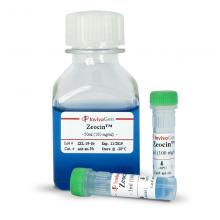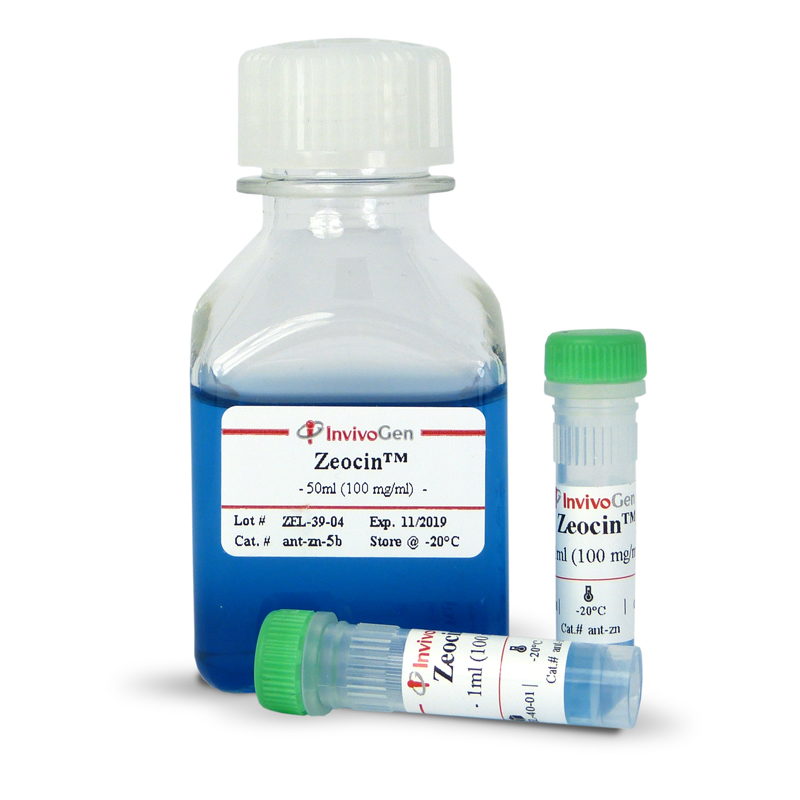Zeocin®
| Product | Unit size | Cat. code | Docs. | Qty. | Price | |
|---|---|---|---|---|---|---|
|
Zeocin® (100 mg/ml solution) Selective antibiotic for the Sh ble gene |
Show product |
500 mg (5 x 1ml) 1g (10 x 1 ml) 5g (50 x 1 ml) 5 g (50 ml bottle) |
ant-zn-05
|
|
||
|
Zeocin® (powder) Selective antibiotic for the Sh ble gene |
Show product |
1 g (powder) 5 g (powder) |
ant-zn-1p
|
|
Selection antibiotic for bacteria and mammalian cells – Endotoxin-tested
Zeocin® is a formulation of phleomycin D1 used for the selection of bacteria and eukaryotic cells, provided as a sterile, cell culture-tested solution or powder. This member of the bleomycin/phleomycin family is a water-soluble, copper-chelated glycopeptide antibiotic, produced by a proprietary strain of Streptomyces verticillus. Zeocin® causes cell death by intercalating into DNA and cleaving it. The action of Zeocin® is effective on most aerobic cells, such as bacteria, eukaryotic microorganisms, plant cells, and animal cells.
Resistance to Zeocin® is conferred by the Sh ble gene product from Streptoalloteichus hindustanus, which inactivates Zeocin® upon binding to the antibiotic [1-3]. Zeocin® is an effective antibiotic for the selection of bacteria and eukaryotic cells expressing the Sh ble resistance. Due to its activity in both E. coli and mammalian cell lines, vectors can be designed that carry only one drug resistance marker for selection.
Suggested concentrations are 50 - 400 µg/ml for selection in mammalian cells and 25 - 50 µg/ml for selection in E. coli.
Key features
- Single producer of Zeocin®
- Each lot thoroughly tested to ensure lot-to-lot reproducibility
- Potency validated in Zeocin®-sensitive and Zeocin®-resistant mammalian cell lines
- Absence of long-term effects confirmed in Zeocin®-resistant cells
Note: Zeocin® is a trademark of InvivoGen registered with the United States Patent and Trademark Office and foreign equivalents.
All InvivoGen products are for internal research use only, and not for human or veterinary use.
References:
1. Drocourt D. et al., 1990. Cassettes of the Streptoalloteichus hindustanus ble gene for transformation of lower and higher eukaryotes to phleomycin resistance. Nucl. Acids. Res. 18: 4009.
2. Gatignol A. et al., 1988. FEBS Letters. 230: 171-5.
3. Dumas P. et al., 1994. Embo J. 242 (5) 595-601.
Specifications
CAS number: 11006-33-0
Appearance (form): Liquid or powder
Appearance (color): Blue
Product concentration: 100 mg/ml (solution)
Buffer: HEPES
pH: 7.1 - 7.7 (solution)
Sterility: 0.2 um filter sterilized
Endotoxin level: < 1 EU/mg
Working concentration: 50 - 400 µg/ml (mammalian cells), 25 - 50 µg/ml (E.coli)
Quality Control: Cell-culture tested
Back to the topContents
Zeocin® is supplied as a sterile filtered blue solution at 100 mg/ml in HEPES buffer.
This product is available in three pack sizes:
- ant-zn-1: 10 x 1 ml (1 g)
- ant-zn-5: 50 x 1 ml (5 g)
- ant-zn-5b: 1 x 50 ml (5 g)
Zeocin® is also supplied as a blue powder:
- ant-zn-1p: 1 x 1 g
- ant-zn-5p: 1 x 5 g
![]() Zeocin® is shipped at room temperature.
Zeocin® is shipped at room temperature.
![]() Upon receipt it should be stored at 4°C or -20°C.
Upon receipt it should be stored at 4°C or -20°C.
![]() Zeocin® is a harmful compound. Refer to safety data sheet for handling instructions.
Zeocin® is a harmful compound. Refer to safety data sheet for handling instructions.
FAQs
Is the Zeocin® you provide hydrochloric or sulfate?
We supply hydrochloric Zeocin®.
Is Zeocin® photosensitive?
No, Zeocin® is not photosensitive.
Is Zeocin® pH sensitive?
Zeocin® will undergo irreversible denaturation at a low and high pH (<6 and >8) or in the presence of a weak oxidant.
What buffer can be used to dilute Zeocin® to make intermediate working solutions?
Further dilutions should be performed in sterile water to create an intermediate working solution.
What is the concentration of HEPES buffer used to reconstitute Zeocin®?
The concentration of HEPES buffer used to reconstitute Zeocin® is 5 g/L.
What is the preferred storage method for Zeocin®?
Zeocin® is shipped at room temperature. Upon receipt, it should be stored at 4°C for short term storage or -20°C for long term storage.
Avoid repeated freeze-thaw cycles.
The expiry date is specified on the product label.
For Zeocin® powder, once resuspended at 100 mg/ml, it can be stored at 4°C for 12 months or -20 °C for 18 months.
For Zeocin® solution, once opened it remains stable for 1 year at -20°C providing you avoid repeated freeze-thaw cycles, and it can be kept at 4°C for 3 months provided it is kept in sterile conditions.
What is the selection concentration of Zeocin® in mammalian cells?
The working concentration of Zeocin® in mammalian cell lines varies between 50 - 400 μg/ml, with a few reported cases of its use at lower (i.e. 20 μg/ml) and higher (i.e. 1000 μg/ml) concentrations. In an initial experiment we recommend to determine the optimal concentration of Zeocin® required to kill your host cell line. For more detailed information, please refer to the technical data sheet for this product.
What is the selection concentration of Zeocin® in E. coli?
Zeocin-resistant transformants are selected in low salt LB agar supplemented with 25 μg/ml of Zeocin®.
Important: Do not use an E. coli recipient strain that contains the Tn5 transposable element (i.e. MC1066). Tn5 encodes a bleomycin-resistance gene that will confer resistance to Zeocin®.






